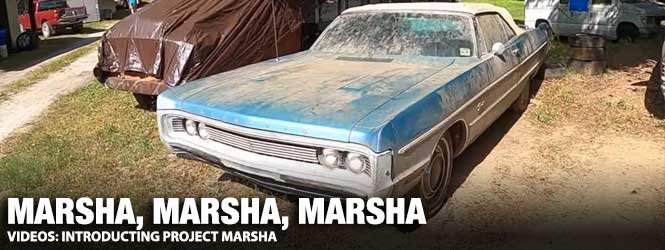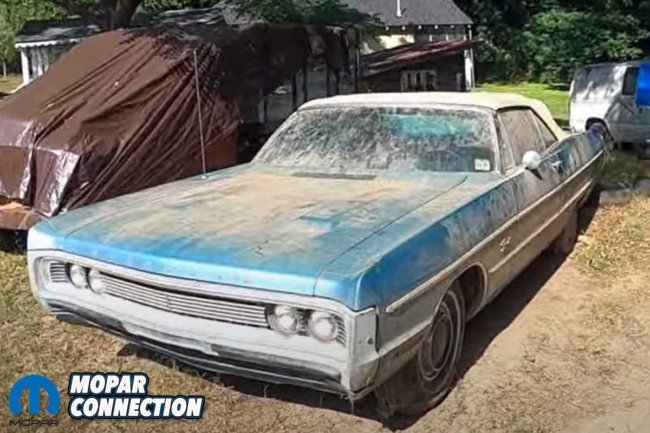
Finding a unique car that sets itself apart from the domestic device crowd can be challenging in a society that considers most vehicles to be appliances. Mopar Connection magazine’s editor-in-chief, Kevin Shaw, took on the challenge and found a 1970 Plymouth Fury III convertible that would stand out when cruising the boulevard or parked at a car show.
The original plan was to pick up the Fury, make a few repairs, and sell it to a Mopar C-body enthusiast for a reasonable profit. However, after Kevin posted a video about the Fury’s condition, followed by a couple of quick repair videos, the Fury garnered way more attention than was initially anticipated. As a result, Kevin’s plans for the Fury quickly changed.
The Fury was officially staying with the magazine but needed a name. In the first year of the Brady Bunch, Mike Brady exchanged a couple of Mopars before settling on a 1970 Fury III convertible, which he kept for the rest of season one and all of season two. Because of the similarities between the two Furys, Mopar Connection magazine proudly introduces with great fanfare the tribute Fury with a stylized name – Project Marsha because Project Mike somehow didn’t have the same appeal.

With an official project name, Kevin developed a goal for Marsha:
“Ultimately, the build is meant to “hang with” but not “compete against” Matt Graves’ “Pro Luxury” g-machine Cadillac. It won’t be near as “built” but a firm handling, 400-450HP cruiser that can cut some cones/corners with the top down and six passengers.”
We compiled a collection of descriptions and the associated videos to bring our readers up to speed about Project Marsha. So, follow along and enjoy the adventures of Marsha.
Marsha’s tale begins at a tobacco farm in North Carolina where a friend of the original owner had the car for sale. A fire chief initially owned it, and Marsha had been equipped with plenty of gear to act as a command post during emergencies. However, Marsha had been stripped of some of its fire-related equipment, but overall, the Fury was in decent shape. It had rust concerns at the front and rear locations around the rear wheel wells and some pinholes in the floorboard, but it was complete.
While on the trip back to Tennessee, Kevin stopped by All Classics Restoration, owned by David Chamberlain, to check on the progress of Project Zombee. The 1970 Dodge Coronet, another Mopar Connection project car, was getting new sheet metal to repair the severe rust concerns.
Once Marsha was in Tennessee, it was given a spot on the driveway, and the evaluation period started. Mopar guru, Jim Hannan, made his first of many visits to help get Marsha’s AVS-equipped 318 running. Fluid changes, manipulation of some stock parts, and new components had Marsha running like it had been parked for a few days instead of more than three decades.
After the success of getting the 318 started, Kevin turned his attention to removing the rusted areas of each quarter panel. First, he cut out the damaged sheet metal, and due to excessive corrosion, he had to damage the wheel opening trim. A pair of quarter panels were purchased to address the rust concerns. Next, Kevin and Jim removed the interior from Marsha to find remnants of mice infestation and some rust damage to the floor pan.
When Marsha was started initially, it was fueled from a small gas container because the factory fuel tank was full of old gas. The fuel tank was in terrible condition, so Kevin picked up a new tank from AMD. He removed the old tank, media blasted the tank straps and the filler neck, and installed the new tank. Kevin had some difficulty with the filler neck fitting correctly into the tank. Nevertheless, Marsha was running on gasoline from its fuel system after the final adjustments.
As with every “project car,” surprises always arise. For Marsha, Jim provided a pair of B-body front seat brackets for the bench seat. The B- and C-body bench seats are the exact dimensions, but the brackets are not the same, which resulted in the seat not being adequately located on the floor. Subsequently, Kevin made a few calls, and he located and installed a pair of the correct brackets.
Marsha’s master cylinder had a leak bypassing the primary piston seal, resulting in fluid leaking down the firewall. Kevin and Jim picked up a remanufactured master cylinder. Following a fight to release the pedal pushrod from the primary piston, they encountered mismatched mounting hardware, which required some “engineering” to install the new master cylinder.
Upon fitting the master cylinder, a new Powermaster alternator was installed. Additionally, Kevin took the time to install a repaired negative ground cable. He placed the cable at the correct factory location on the cylinder head, not the exhaust manifold as a previous owner had. As a result of the new electrical components, the electrical system was again functional.
The AVS on Marsha was worn out and required a rebuild. All the parts for the AVS were procured from Mike’s Carburetor Shop. Jim took the time to rebuild the AVS using his extensive knowledge of the nuances of Carter carburetors. With the AVS back on the 318, Jim fine-tuned the carb to get the best idle and snap throttle action. The real test was on display when Kevin attempted to perform a burnout. The keyword is attempted. Lastly, Marsha made its maiden voyage and got a well-deserved pressure wash at a local car wash.
Even with the rebuilt AVS, Marsha was way down on power. So, with the help of Mark Pool, a compression test was performed on the 318. It turned out that cylinders 1, 3, and 7 had less than 35psi of cranking pressure. After some investigation, several bent pushrods were found, and they matched the three low-pressure cylinders.
The fix was to remove the driver-side cylinder head and free up the stuck valves. Later, Jim and Kevin cleaned up the valves and guides and added new valve seals, and then they reinstalled the head along with several new pushrods. The engine was started, and the idle speed was adjusted. The 318 sounded better, and there was better throttle response. Eventually, the exhaust blue oil fog emissions resolved themselves, but the burnout attempt failed again.
Although a new transmission would not be needed until a big-block was installed, Jim did a tutorial on the DIYer rebuild of a Torqueflite 727 automatic transmission. His experience as a Chrysler line technician with a particular emphasis on transmissions made him the best person to handle the rebuild. Jim completed his service with products from TCI.
Marsha has been a single-wheel peel since it left the factory in 1970. That would change as Kevin got his hands on an Eaton Trutrac sure-grip differential. With help from Mark, the two set up a new 8 ¾-inch rear end for Marsha. Kevin swapped the factory carrier assembly, which turned out to have 2.76:1 gears, for the new Eaton unit with 3.23:1 gears. Finally, Marsha could light up the tires but only after backing down a boat loading dock to sufficiently wet them.
With the new gears in Marsha, it was time to monitor the engine speed. Kevin took the time to install a Sun Super Tach II. He discussed the routing of the four tach wires and contemplated the best location for the tach on the steering column. When he finished, the tachometer’s housing did not interfere with the visibility of the gauges on the cluster. Best of all, Kevin could now monitor the engine rpm rather than guessing.
Early in the video series, the rusted metal in the quarter panels was cut out. The time had come to treat all the exposed metal and attempt to fit the quarter panels Kevin had purchased a few months prior. Unfortunately, almost from the beginning, he experienced difficulties with the patches. The replacement panels left a lot to be desired. The more he worked on the panels, the worse they seemed.
Eventually, Kevin pulled the plug on the patch panels. David Chamberlin agreed to take on the body repairs to Project Marsha. To move Marsha into the queue, Kevin delivered the Fury to All Classics Restoration and picked up Project Zombee, which was taken to Finale Speed.
The most recent video installment is a wrap-up of the initial series of Project Marsha videos and where the project stands. And with that, our readers should be current on the happenings with Marsha but stay tuned to Mopar Connection magazine for additional updates and videos.















 Mopar Connection Magazine – The ONLY Daily Mopar Magazine © 2022. All Rights Reserved. Mopar Connection Magazine is the ONLY daily Mopar Magazine bringing you the latest Mopar news, technology, breaking news, and Mopar related events and articles. Find out the latest information about Mopar, Mopar products and services, stay up to date on Mopar enthusiast news, dealership information and the latest Mopar social media buzz! Sign up for the Mopar Connection Magazine newsletter for the latest information about new products, services and industry chatter. Mopar Connection Magazine is the best and only source you need to be a Mopar industry insider!
Mopar Connection Magazine – The ONLY Daily Mopar Magazine © 2022. All Rights Reserved. Mopar Connection Magazine is the ONLY daily Mopar Magazine bringing you the latest Mopar news, technology, breaking news, and Mopar related events and articles. Find out the latest information about Mopar, Mopar products and services, stay up to date on Mopar enthusiast news, dealership information and the latest Mopar social media buzz! Sign up for the Mopar Connection Magazine newsletter for the latest information about new products, services and industry chatter. Mopar Connection Magazine is the best and only source you need to be a Mopar industry insider! by
by